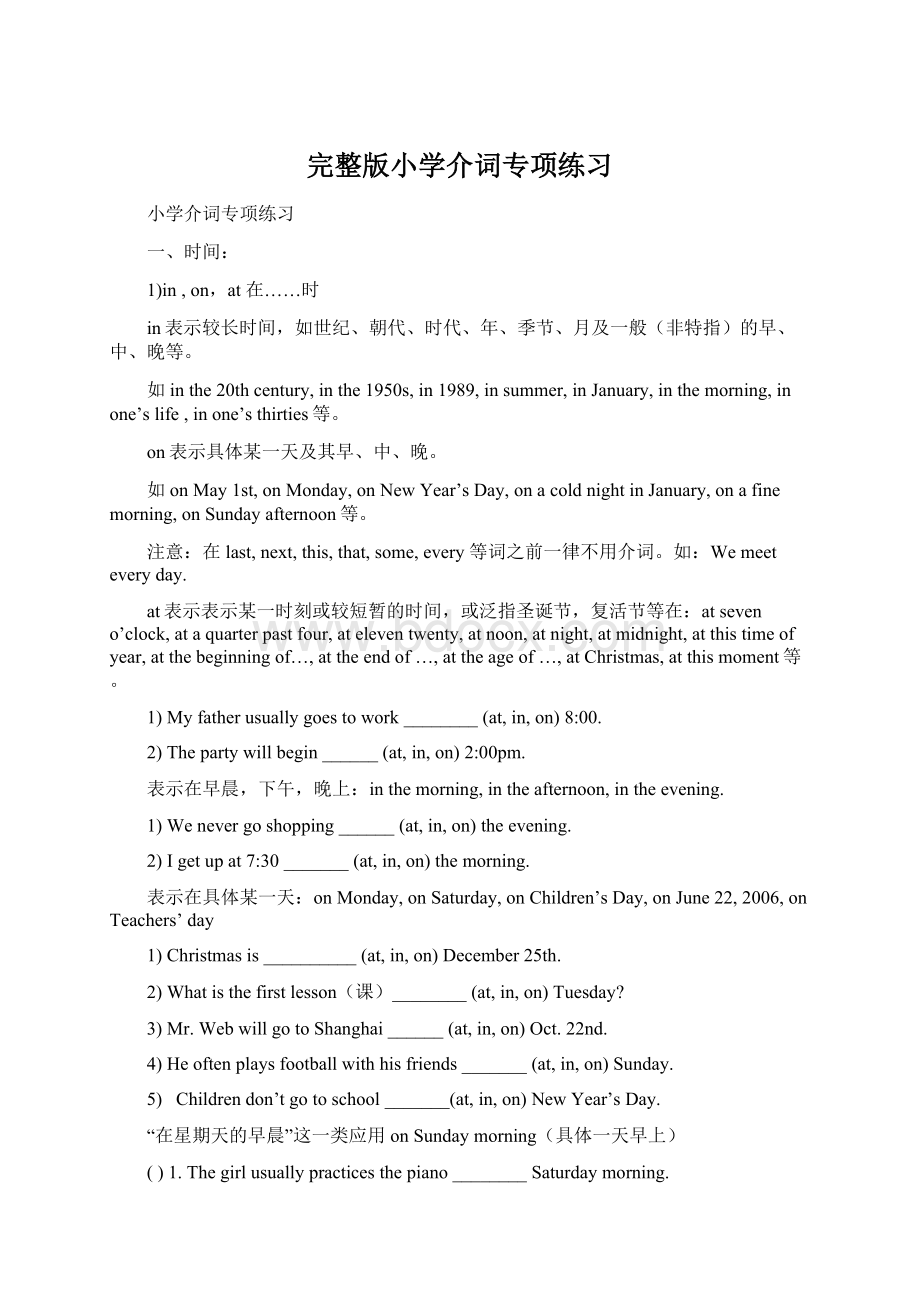完整版小学介词专项练习.docx
《完整版小学介词专项练习.docx》由会员分享,可在线阅读,更多相关《完整版小学介词专项练习.docx(13页珍藏版)》请在冰豆网上搜索。

完整版小学介词专项练习
小学介词专项练习
一、时间:
1)in,on,at在……时
in表示较长时间,如世纪、朝代、时代、年、季节、月及一般(非特指)的早、中、晚等。
如inthe20thcentury,inthe1950s,in1989,insummer,inJanuary,inthemorning,inone’slife,inone’sthirties等。
on表示具体某一天及其早、中、晚。
如onMay1st,onMonday,onNewYear’sDay,onacoldnightinJanuary,onafinemorning,onSundayafternoon等。
注意:
在last,next,this,that,some,every等词之前一律不用介词。
如:
Wemeeteveryday.
at表示表示某一时刻或较短暂的时间,或泛指圣诞节,复活节等在:
atseveno’clock,ataquarterpastfour,ateleventwenty,atnoon,atnight,atmidnight,atthistimeofyear,atthebeginningof…,attheendof…,attheageof…,atChristmas,atthismoment等。
1)Myfatherusuallygoestowork________(at,in,on)8:
00.
2)Thepartywillbegin______(at,in,on)2:
00pm.
表示在早晨,下午,晚上:
inthemorning,intheafternoon,intheevening.
1)Wenevergoshopping______(at,in,on)theevening.
2)Igetupat7:
30_______(at,in,on)themorning.
表示在具体某一天:
onMonday,onSaturday,onChildren’sDay,onJune22,2006,onTeachers’day
1)Christmasis__________(at,in,on)December25th.
2)Whatisthefirstlesson(课)________(at,in,on)Tuesday?
3)Mr.WebwillgotoShanghai______(at,in,on)Oct.22nd.
4)Heoftenplaysfootballwithhisfriends_______(at,in,on)Sunday.
5) Childrendon’tgotoschool_______(at,in,on)NewYear’sDay.
“在星期天的早晨”这一类应用onSundaymorning(具体一天早上)
()1.Thegirlusuallypracticesthepiano________Saturdaymorning.
A.onB.inC.at
()2.Helefthome___acoldwinterevening.
A.atB.onC.in
表示大约时间(about):
It'saboutsixo'clocknow.现在大约6点钟了。
表示一段时间(for):
fortwoyears,(howlong)(任何时态)
表示一段时间之后(in):
intwodays,(howsoon)(将来时)
after+时间段,常用于过去时:
这里的时间段一般不是具体时间,一般不说afterthreedays,而是threedaysafter,但可以说afteraperiodoftime,如:
Afterawhile,hecamehere.
after+时间点,可用于各种时态:
AfterdinnerIwatchTV.晚饭后我看电视。
Afterfive,hecamehere.
一段时间+later/ago,分别表示“(多久)以后/以前”,主要用于过去时态。
after/before+某个时刻,分别表示“在某时刻之后/之前”,此时两个词是介词。
ago与before:
ago只能用于过去时,before用于完成时。
如:
Hehadanaccidentaweekago.(一周前出了一个事故).
Someyearslater,theboybecameaveryfamoussinger.
(数年后这个男孩成了著名的歌唱家).
Haveyoubeentherebefore?
(你从前到过那儿吗?
).
Afterafewyearshegaveupsmoking.(过了几年他戒了烟。
)
since+时间点,常用于完成时态:
sincethreedaysago,IhavelivedheresinceIwastenyearsold.
until+时间点(特定的时间,某事发生):
直到……为止,在……之前
notuntil+时间点(特定的时间,某事发生):
直到……才
Hedidn’tturnupuntilhalfanhourlater.(半小时后他才出现)
assoonas一….就
when与while
(1)when既指时间点,也可指一段时间,while只指一段时间,因此when引导的时间状语从句中的动词可以是终止性动词,也可以是延续性动词,而while从句中的动词必须是延续性动词。
(2)when说明从句的动作和主句的动作可以是同时,也可以是先后发生;while则强调主句的动作在从句动作的发生的过程中或主从句两个动作同时发生。
(3)由when引导的时间状语从句,主句用过去进行时,从句应用一般过去时;如果从句和主句的动作同时发生,两句都用过去进行时的时候,多用while引导,如:
Whentheteachercamein,weweretalking.
当此句改变主从句的位置时,则为:
Whileweweretalking,theteachercamein.
Theyweresingingwhileweweredancing.
(4)when和while还可作并列连词。
when表示“在那时”;while表示“而,却”,表对照关系。
如:
Thechildrenwererunningtomovethebagofricewhentheyheardthesoundofamotorbike.
孩子们正要跑过去搬开那袋米,这时他们听到了摩托车的声音。
Heisstrongwhilehisbrotherisweak.
他长得很结实,而他弟弟却很瘦弱。
时间相关的固定搭配:
atfirst起初;
atlast最后
atpresent现在
atthesametime同时
ontime准时地
intime及时地
atonce立刻;马上
inaminute立刻
inahurry匆忙地
intheend相当于atlast,finally,是副词,意思是“最后,最终,终于”如:
Intheend,shefoundthesolutiontotheproblem.(最后,她找到了解决这个问题的方法.)
attheend通常后边要跟上其它成分,即完整的形式是:
attheendofsth,意思是“在...的末尾,在...结束的时候”,如:
Attheendofthemonth,shefinishedthetask.(在月末的时候,她完成了任务.)
atschool在上课,在上学(=inschool在求学、在上学)
inhospital住院
atwork上班,在工作
inclass在课堂上
onduty值日
onholiday度假
atschool表示“在学校、在上学”相对于在家里或在校外,强调所在场所或时间,如:
Mysonisatschoolnow.Heisnotathomeorsomewhereelse.
我儿子现在在学校,他不在家,也不在别的地方。
inschool“在求学、在上学”相对于有工作,强调主语的身份是学生。
如:
Mydaughterstillinschool,Shedoesn’twork.。
我女儿还在上学,她不在工作。
ina/theschool“在学校”,不一定指上学。
类似的还有:
inhospital“生病住院”
ina/thehospital表“在医院”(工作或探视病人等)
on/duringone’sbirthday
不加介词的时间短语:
1.next,last,thenext,thelast加时间名词做状语时,其前可不用介词。
例如:
Heisgoingtomeetmyparentsnextweek.
下周他要见我的父母。
Whowasondutylastweek?
上周谁值日?
2.this,that,these,those构成的时间状语前可不用介词。
例如:
(time、day例外)
WearegoingtohaveanewEnglishbookthisyear.
今年我们将有一本新英语书。
Hedidn'tgobackthatnight.
那晚他没有回来。
3.today,tomorrow,yesterday,thedaybeforeyesterday,thenightbeforelast,thedayaftertomorrow前不用介词。
例如:
Whoisondutytoday?
今天谁值日?
Hegotupearlyyesterday.
昨天他起得早。
4.由one,any,each,every,some等构成的时间状语前,可不用介词。
例如:
Tomgetsupatsixeverymorning.
汤姆每天早晨6点钟起床。
Youcancometoaskmeanytimeyoulike.
在你方便的时候可以来找我。
5.以all开头的时间状语(如alltheweek,allday等)之前,可以不用介词for。
例如:
Shewasbusyalldayyesterday.
她昨天忙了一整天
2)in,after在……之后
“in+段时间”表示将来的一段时间以后;
“after+段时间”表示过去的一段时间以后;
“after+将来点时间”表示将来的某一时刻以后。
3)from,since自从……
from仅说明什么时候开始,不说明某动作或情况持续多久;since表示某动作或情况持续至说话时刻,通常与完成时连用。
4)after,behind在……之后
after主要用于表示时间;
behind主要用于表示位置。
二、地点位置:
1)at,in,on,to
at
(1)表示在小地方;
(2)表示“在……附近,旁边”,atthebookstore,atthebookshop,atthecinema,atDisneyland,atthepark,atthethirdcrossing,atthebusstop,atthestation,attherestaurant.athome
in
(1)表示在大地方;
(2)表示“在…范围之内”。
intheclassroom,intheroom
on表示毗邻,接壤,“在……上面”。
ontheroad,
to表示在……范围外,不强调是否接壤;或“到……”,totheeastofChina
2)above,over,on在……上
above指在……上方,不强调是否垂直,与below相对;
over指垂直的上方,与under相对,但over与物体有一定的空间,不直接接触。
on表示某物体上面并与之接触。
Thebirdisflyingabovemyhead.
Thereisabridgeovertheriver.
Heputhiswatchonthedesk.
3)below,under在……下面
under表示在…正下方
below表示在……下,不一定在正下方
Thereisacatunderthetable.
Pleasewriteyournamebelowtheline.
4)infrontof,inthefrontof在……前面
infrontof…意思是“在……前面”,指甲物在乙物之前,两者互不包括;其反义词是behind(在……的后面)。
Therearesomeflowersinfrontofthehouse.(房子前面有些花卉。
)
inthefrontof意思是“在…..的前部”,即甲物在乙物的内部.反义词是atthebackof…(在……范围内的后部)。
Thereisablackboardinthefrontofourclassroom.我们的教室前边有一块黑板。
Ourteacherstandsinthefrontoftheclassroom.我们的老师站在教室前.(老师在教室里)
5)beside,behind
beside表示在……旁边
behind表示在……后面
3.表运动方向的介词:
across,through通过,穿过
across表示横过,即从物体表面通过,与on有关;
through穿过,即从物体内部穿过,与in有关。
4.表示“在……之间”的介词:
between,among
between指在两个人或两个事物之间;
among指在三个或三个以上的人或事物之间。
ontheleft和ontheright
in和out
near/nextto
5.表示其他意义的介词
1)on,about关于
on表示这本书,这篇文章或演说是严肃的,或学术性的,可供专门研究这一问题的人阅读;
about表示内容较为普通,不那么正式。
2)by,with,in表示方法、手段、工具
by以……方法、手段或泛指某种交通工具;
with表示用…工具、手段,一般接具体的工具和手段;in表示用…方式,用…语言(语调、笔墨、颜色)等;
3)except,besides除了
except除……之外,不包括在内;
besides除……之外,包括在内。
ExceptMr.Wang,wewenttoseethefilm.(王先生没去)
BesidesMr.Wang,wealsowenttoseethefilm.(王先生也去了)
ontheradio在广播中
onTV在电视上播放
ontheInternet在互联网上
onthephone通过电话
onsale出售;降价出售
ontheleft/right在左/右边
onfoot步行
ontheway在路上/intheway以什么方式
laughat嘲笑
learnfrom向……学习/learnabout/learnby/learntodo
lookafter照顾
lookfor寻找/lookover
thinkof/thinkabout/thinkover
worryabout担心
listento听
lookat看;注视
talkabout交谈;谈/talkto/talkwith
waitfor等候;等
thankfor为……而感谢
3)形容词和介词连用
beafraidof害怕
becarefulwith小心;关心
beinterestedin对……感兴趣
begoodat善于
beproudof感到自豪
inall总体
belatefor干某事迟到
inEnglish用英语
begoodfor对……有利
inshort总之
4)其他
by+交通工具
bybus/train/plane/air/ship/bike/sea/land…
inbed躺在床上
lotsof/alotof许多,大量
indanger在危险中
infact事实上atleast至少
inorderto为了
()1.Isthereariver______thehouse?
A.toB.ofC.inD.behind
()2.They’rerunning_______theplayground.
A.withB.inC.at
()3.Canweeat_______GuangzhouRestauranttoday?
A.toB.ofC.at
()4.ShestudiesEnglish______RoseSchool____England.
A.at,fromB.in,inC.at,in
()5.Aplaneisflying____thecity.
A.onB.overC.above
()6.Therearemanyapples___thetree.Abird___thetreeispickinganapple.
A.in;onB.on;inC.in;at
1.有独立意思的:
1)with和…一起并列的成分分开使用时用with
Iwenttothegarden________Tom.
LiuTaoisgoingtovisithisgrandpa_______hisparents.
with带有Theboy________________isDavid.那个有着一双大眼睛的是大卫。
Theschool_________________________isoverthere.
那边的那个学校有34间教室。
Theboy______________________inhishandlikesreading.
那个手里拿着一本书的男孩很爱读书。
with用Touchyourheadwithyourhands
2)of“的”
___________________________________________,新学期的第一天
___________________________________________一张吉姆家人的照片
___________________________________________学校的名字
of量词的运用
___________________________________________一杯
3)from..从,来自,向
TomtheUK.汤姆来自于英国。
ThestudentslearnEnglish.学生们从我这里学英语。
4)about关于(谈话的内容,故事的内容,)
Theytheweekends.他们正在谈论周末。
5)on作“关于”讲,表示论题。
如:
一本关于收音机的书。
6)like作“像……”解,表示相似。
如:
看起来像
7)in表示“穿着”,“戴着”或“用某种语言、材料”等。
如:
穿着红色衣服的女人;
用英语讲;用墨水
8)as作“作为”解,表示身份。
作为一个老师
9)about(大约),over(\=morethan)(多于,超过),below(=lessthan)(少于,不足)等介词表示“数”
about/over/below/2,000people
10)without表示“没有”,“无”。
thereisnothing.没有水就没有一切。
11)by表示“通过交通工具、手段、通讯方式”等。
如:
乘公共汽车乘火车
乘飞机乘船
12).for表示动作的对象或接受者(为、给,对于…)、作为、目的、原因、时间、距离(计、达)。
Whatwillwehave?
我们晚餐吃什么?
Thankyousowell.感谢你如此尽心地教我们。
WatchingTVtoomuchyourhealth.看电视太多有害于你的健康。
Iusuallydotherunninginthemorning.我早晨通常跑步一小时。
Wewillstaythere.我们将在那里逗留两天。
Let’sgoforawalk.我们出去散步吧。
13).on,over,by作“通过”解,表示“途径”。
如:
通过收音机;通过电视;乘公共汽车
15)固定词组:
lookforlookafterondutylookat
listentoofcoursegetsthforsbstayinbed
writeane-mail/aletterto..talkabout…
talktosbfrom…to…onfoot
一、选择填空,并把其字母编号写在括号内。
()1.It’stime______supper.
A.atB.inC.onD.for
()2.It’snotime______school.It’stime______gobackhome.
A.to,forB.to,toC.for,to
()3.MrBrowncomes______America.